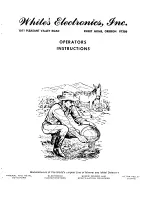
- 40 -
Einsatz in der Praxis
1. Wählen Sie eine geeignete Stellen, z.B. eine Rasenfläche, in der sich
keine Metallgegenstände im Boden befinden.
2. Legen Sie einen Metallgegenstand wie z.B. eine Münze auf den Boden,
um diese übungshalber aufzuspüren.
3. Drehen Sie den VOLUME Regler etwa zwei Drittel nach rechts.
4. Auf den roten Knopf drücken und langsam den TUNE Regler drehen, bis
die Nadel des Drehspulmessers in der Mittelstellung ist.
Bewegen Sie nun die Suchscheibe in einer Höhe von 50cm über dem
Boden gleichmäßig hin und her, wie es in der Abb. gezeigt ist.
Führen Sie die Suchscheibe parallel zur
Bodenoberfläche.
Bewegen Sie die Suchscheibe langsam, um keine Gegenstände zu
verpassen.
Überprüfen Sie, ob Sie einen Ton hören und die Nadel ausschlägt, wenn
Sie die Suchscheibe über den Metallgegenstand führen. Beachten Sie,
dass der Metalldetektor nur reagiert, wenn die Suchscheibe bewegt wird.
- 13 -
As you set
DISCRIMINATION
to higher levels, the detector first does not
detect small pieces of silver paper, then thick foil, and finally metal objects
like pull tabs from aluminum cans.
Note
: Each time you use the detector in a different area, you must readjust
DISCRIMINATION
. Each search location presents new challenges.
FALSE SIGNALS
Because your detector is extremely sensitive, trash-induced signals and
other sources of interference might cause signals that seem confusing. The
key to handling these types of signals is to dig for only those targets that
emit a strong, repeatable signal. As you sweep the search coil back and
forth over the ground, learn to recognize the difference between signals that
occur at random and signals that are stable and repeatable.
To reduce false signals when searching very trashy ground, scan only a
small area at a time using slow, short overlapping sweeps.
DETECTION HINTS
No detector is 100 percent accurate. Various conditions influence metal
detection. The detector’s reaction depends on a number of things:
♦
The angle at which the object rests in the ground
♦
The depth of the object
♦
The amount of iron in the object
♦
The size of the object
PINPOINTING A TARGET
Accurately pinpointing a target makes digging it up easier.
Accurate pinpointing takes practice, and we suggest you practice finding
and digging up small metal objects on your own property before you search
other locations.
Sometimes, targets are difficult to accurately locate due to the sweep
direction. Try changing you search other locations.
Sometimes, targets are difficult to accurately locate due to the sweep
direction. Try changing your sweep direction to pinpoint a target.
Follow these steps to pinpoint a target.
1. When the detector detects a buried target, continue sweeping the search
coil over the target in a narrowing side-to-side motion.
2. Make a visual note of the exact spot on the ground where the detector












































